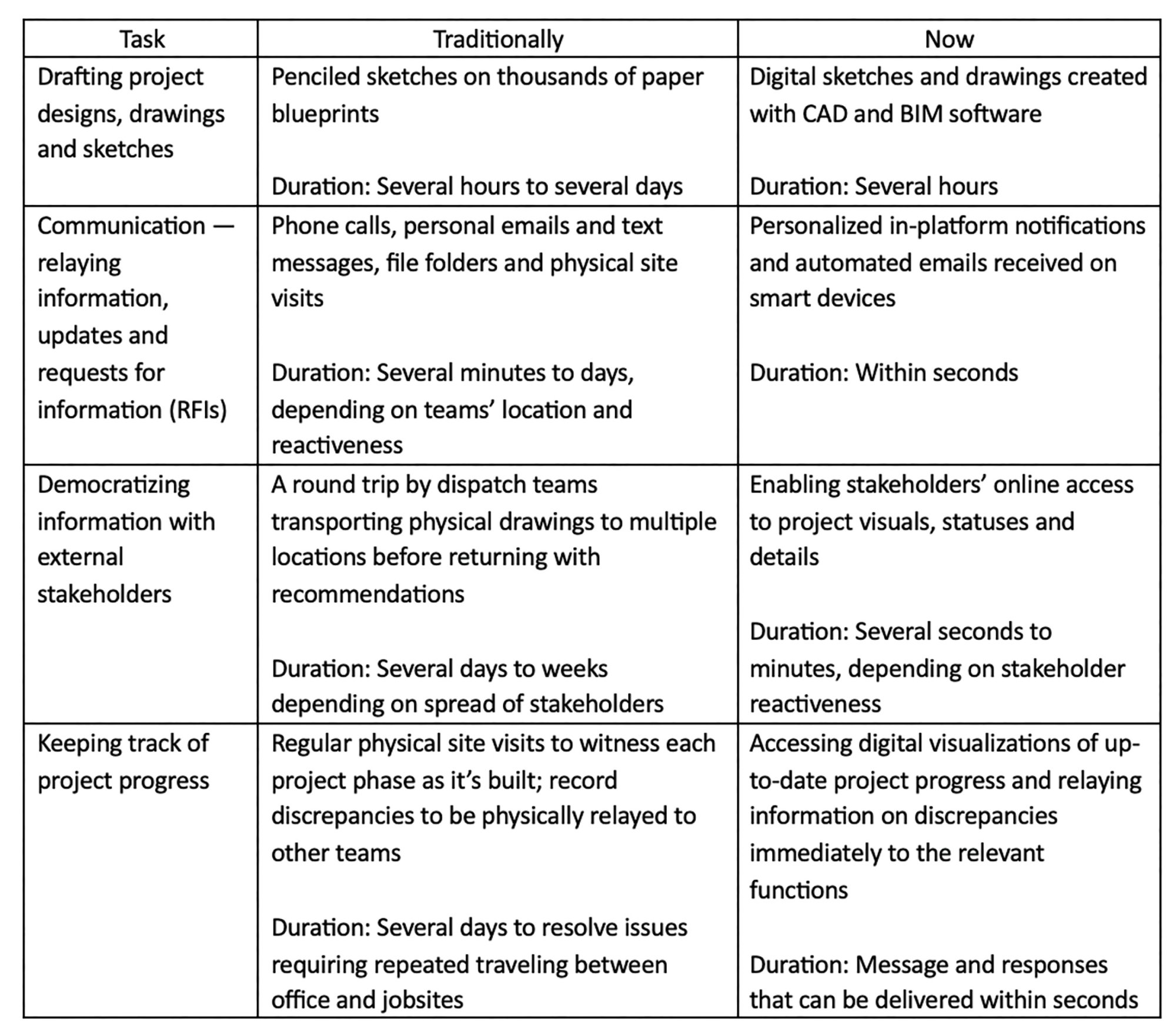
Success on complex and sizable construction projects requires more than just hard work, cooperation and trust in your team. In today’s digitally charged work environment, leveraging technology as your catalyst toward greater profitability is seen as a necessity rather than a luxury.
Yes, some of us might still be lugging around hard copies of site and project documentation just in case something happens to the digital copies. Some see it as a way to democratize information with teammates and partners by showing them actual sketches. However, just like technology inspires exponential performance gains in other industries, solutions aiming to digitize entire jobsites are catapulting construction firms and their project partners to greater heights without experiencing difficult operational changes or downtimes.
Key Data Types Used on Construction Projects & Their Applications
As you add tools to your digital jobsite kit, you will notice several data formats, processes and platforms are more widely used
than others.
1. 3D Models (BIM Data/CAD Files)
3D modeling data for architecture, engineering and construction (AEC) comes in various formats, and many see it as a prerequisite for success. In today’s building information modeling (BIM) landscape, construction firms often rely on computer-aided design (CAD)-compatible data to develop, analyze and manipulate digital models of projects before any foundation is set. That data is leveraged throughout a project, with contractors and trade partners relying on it as a digital blueprint for design and dimensions. BIM data operates as an extension of CAD models, as the process enables the visualization of parametric, generative and operational data used throughout a structure’s life cycle.
2. 3D Point Clouds/Lidar Site Scans
Obtained through terrestrial, mobile and handheld scanners, point cloud data provides construction teams with a 3D representation of jobsites. Teams leverage point clouds to measure, analyze and compare as-builts against design models, saving countless hours otherwise spent on manual measurements. The millimeter-level accuracy of terrestrial point cloud data, paired with its compatibility to integrate with other datasets, provides the ability for deep-seated analysis to support quality control, prefabrication, floor flatness, steel deformation as well as the generalized BIM process. Mobile site scans using simultaneous localization and mapping (SLAM) technology provide the balance of speed and accuracy for large areas both interior and exterior where spatial context is needed, while iPhone lidar enables quick capture where speed is of the essence, and ease of use allows anyone to capture 3D data to provide visual representation and context.
3. 360-Degree Site Photos
360-degree photos are usually taken with 360-degree cameras that can capture the surrounding area in one photo and are often used to document entire jobsites quickly. Construction progress tracking software aligns 360-degree photos captured on-site with the existing floor plans, providing teams with an up-to-date visual twin of current project conditions. This enables teams to document, identify and address issues fast, mitigating costly mistakes.
4. A Platform to Process & Visualize Data
At the crux of data democratization efforts is the ability to manage, leverage and disseminate information to relevant stakeholders. Usually called digital jobsites, these robust tools enable the seamless sharing of reality capture and 3D model datasets by unifying them into a single platform.
The cross-compatibility of digital jobsites with documentation and scheduling tools like Navisworks and Bluebeam enables greater alignment across project delivery teams. Ultimately, this creates a single source of truth for your project’s operational and administrative aspects, making coordination a breeze. Conversely, poor execution of a digitization strategy results in scattered and misplaced communications, making it challenging to stay on top of things.
How Data Democratization Contributes to Success
A comprehensive digitization strategy has phased out archaic paper-based workflows. In its place today, we have digital and technologically advanced tools that bring in immeasurable gains in terms of speed, productivity and accuracy on projects, pushing the boundaries of success.
How Things Are Done on the Job: Then vs. Now
To illustrate the immediate benefits data democratization brings to your firm, we detail how these optimizations impact everyday work on jobsites.

Communication & Collaboration
As illustrated in Figure 1, communication through digital jobsites gets the message across within seconds. Relevant stakeholders and trade partners will be notified about issues within a digital jobsite, enabling quick decision-making. The compatibility of these cloud-based platforms with multiple data formats enables information and context to be easily understood by those in different functions throughout the project hierarchy.
In addition to communicating instructions and recommendations quickly, digital jobsites allow for frictionless collaboration between teams and external stakeholders, keeping everyone on the same page. Integrated permissions within digital jobsites enable relaying cascading instructions, notifying partners only when required.
Timelines usually considered vague completion dates can now be established through digital rendering of upcoming work before installation of fittings, roofing or flooring. This allows for more efficient use of human and material resources based on what is required at specific points in time instead of aspirational scheduling. Digital workstations also enable remote monitoring by project owners and decision-makers, which helps to reduce head count and the risk of untoward incidents from overcrowded jobsites.
Accuracy on Projects
With communication and collaboration now a seamless process, other aspects of your project will also improve accuracy and efficiency through democratization.
Vendors, Suppliers & Fabricators
Giving vendors, suppliers and fabricators access to a digital jobsite provides everyone with a single source of truth, facilitating smoother collaboration by providing exact information for purchase orders on materials and supplies needed. Gone are the days of suppliers delivering 8-by-8-foot monstrosities instead of 8-by-8-inch frames.
Delivery Teams & External Stakeholders
On-site and remote teams are empowered to collaborate effectively. Ensuring that construction is completed according to contractual requirements can be done remotely, along with quality inspections, installation verifications and work approvals. Deviations and discrepancies are detected ahead of time through virtual assessments, allowing immediate remedial work to take place before these issues exacerbate.
Profitability
Workflow optimizations using data democratization, bottom-line performance, and return on investment (ROI) from these digital tools will scale toward more prominent projects. Improvements of speed and efficiency outweigh and justify the financial commitments needed, eventually “paying for themselves.”
Democratization of data helps avoid cost overruns, inaccurate purchase orders, change orders and erroneous installations. Firms with an effective democratization strategy today are no longer experiencing bell-curve-styled cost impacts that strain resources midway through a project. Cost implications are instead experienced in a more linear and gradual ascent thanks to planning and corrective measures undertaken earlier, making it easier to manage financial resources.
In today’s competitive landscape, it’s imperative for firms to keep focus on efficiency, productivity and accuracy by leveraging today’s technology. Unifying all your project data in a digital jobsite will become a baseline instead of a luxury both now and in
the future.
Consistent and efficient use and advocacy for such innovative tech only elevate your firm’s reputation and profitability, attracting work with larger corporations. Digitizing your firm and project repositories can also help with legal and contractual compliance if disputes arise.
